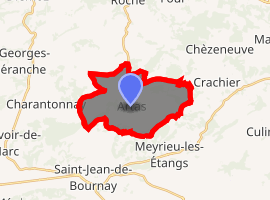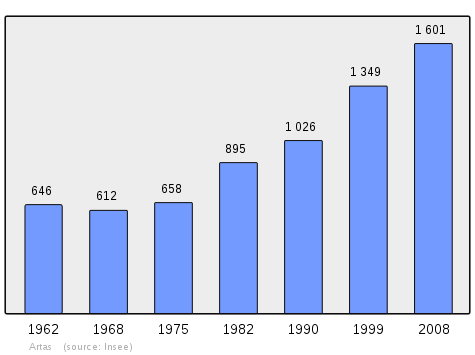Artas, Isère
Artas (Occitan: Artàs) is a commune in the Isère department in the Auvergne-Rhône-Alpes region of south-eastern France.
Artas | |
|---|---|
The road into Artas | |
Location of Artas 
| |
 Artas  Artas | |
| Coordinates: 45°32′10″N 5°09′54″E | |
| Country | France |
| Region | Auvergne-Rhône-Alpes |
| Department | Isère |
| Arrondissement | Vienne |
| Canton | La Verpillière |
| Intercommunality | CC Région Saint-Jeannaise |
| Government | |
| • Mayor (2014-2020) | Martial Simondant |
| Area 1 | 14.15 km2 (5.46 sq mi) |
| Population (2017-01-01)[1] | 1,809 |
| • Density | 130/km2 (330/sq mi) |
| Time zone | UTC+01:00 (CET) |
| • Summer (DST) | UTC+02:00 (CEST) |
| INSEE/Postal code | 38015 /38440 |
| Elevation | 364–507 m (1,194–1,663 ft) |
| 1 French Land Register data, which excludes lakes, ponds, glaciers > 1 km2 (0.386 sq mi or 247 acres) and river estuaries. | |
The inhabitants of the commune are known as Artasiens or Artasiennes[2]
Geography
Artas is located some 20 km east by north-east of Vienne and some 8 km south of Villefontaine. Access to the commune is by the D53 road from Charantonnay in the west passing through the heart of the commune and the village and continuing to Saint-Agnin-sur-Bion in the east. The D126 road comes from Roche in the north through the heart of the commune and crossing the D53 in the village before continuing to Saint-Jean-de-Bournay in the south. Apart from the village there are also the hamlets of Le Barroz, Le Revolet, Cinquin, Radoire, Tarnezieux, and La Petite-Foret. The commune is mainly farmland with scattered forests throughout.[3]
The Ruisseau de Charavoux rises in the west of the commune and flows west to join the Ambalon near Chasse-sur-Rhône.[3]
Neighbouring communes and villages[3]
History
In the reign of Louis XIV the Oak trees from the Artas Forest provided a large part of the wood needed to build the King's Galleys at Marseille.
Artas was the birthplace of Mother's Day in France on 10 June 1906 - two years earlier than the date of origin of 1908 claimed by the USA.[4]
Administration
List of Successive Mayors[5]
| From | To | Name | Party | Position |
|---|---|---|---|---|
| 2001 | 2014 | Maurice Barale | UMP | |
| 2014 | 2020 | Martial Simondant |
(Not all data is known)
Demography
In 2010 the commune had 1,620 inhabitants. The evolution of the number of inhabitants is known from the population censuses conducted in the commune since 1793. From the 21st century, a census of communes with fewer than 10,000 inhabitants is held every five years, unlike larger towns that have a sample survey every year.[Note 1]
| 1793 | 1800 | 1806 | 1821 | 1831 | 1836 | 1841 | 1846 | 1851 |
|---|---|---|---|---|---|---|---|---|
| 1,085 | 1,159 | 1,101 | 990 | 1,253 | 1,346 | 1,320 | 1,181 | 1,325 |
| 1856 | 1861 | 1866 | 1872 | 1876 | 1881 | 1886 | 1891 | 1896 |
|---|---|---|---|---|---|---|---|---|
| 1,302 | 1,224 | 1,203 | 1,212 | 1,088 | 1,071 | 1,052 | 1,045 | 1,025 |
| 1901 | 1906 | 1911 | 1921 | 1926 | 1931 | 1936 | 1946 | 1954 |
|---|---|---|---|---|---|---|---|---|
| 986 | 1,000 | 993 | 874 | 840 | 793 | 750 | 692 | 667 |
| 1962 | 1968 | 1975 | 1982 | 1990 | 1999 | 2006 | 2010 | - |
|---|---|---|---|---|---|---|---|---|
| 646 | 612 | 658 | 895 | 1,026 | 1,349 | - | 1,620 | - |

Sites and monuments
- A Church with two bell towers from the 12th and 19th centuries.
Artas Picture Gallery
- Artas Girls' School
- Artas Landscape
- The old Town Hall
- A street in Artas
See also
External links
- Artas official website (in French)
- Artas on the National Geographic Institute website (in French)
- Artas on Lion1906
- Artas on Géoportail, National Geographic Institute (IGN) website (in French)
- Artas on the 1750 Cassini Map
Notes and references
Notes
- At the beginning of the 21st century, the methods of identification have been modified by Law No. 2002-276 of 27 February 2002 Archived 6 March 2016 at the Wayback Machine, the so-called "law of local democracy" and in particular Title V "census operations" allows, after a transitional period running from 2004 to 2008, the annual publication of the legal population of the different French administrative districts. For communes with a population greater than 10,000 inhabitants, a sample survey is conducted annually, the entire territory of these communes is taken into account at the end of the period of five years. The first "legal population" after 1999 under this new law came into force on 1 January 2009 and was based on the census of 2006.
References
- "Populations légales 2017". INSEE. Retrieved 6 January 2020.
- Inhabitants of Isère (in French)
- Google Maps
- Artas Official website (in French)
- List of Mayors of France (in French)
| Wikimedia Commons has media related to Artas (Isère). |